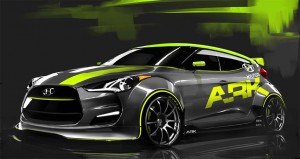As regular readers of TheDetroitBureau.com know, we recently gave a generally positive review to the new Hyundai Veloster, an affordable and distinctively styled coupe that replaces such past throw-away offerings as the Tiburon. If one thing was missing, we noted, it was a bit more muscle.
(Click Here for the review.)
Well, if the Hyundai ARK Performance Veloster is any indication, perhaps the Korean carmaker has been listening. The prototype, unveiled in these renderings prior to its official launch at the 2011 SEMA aftermarket show in Las Vegas, puts the new 3-door on steroids.
The one-off pumps up the basic 1.6-liter inline-four engine from a mere 138 horsepower to 210 with the addition of a twin-scroll supercharger. Other changes ensure that anyone in your path is likely to get out of the way. The real question is not whether the ARK-tuned Veloster is fast but how fast we might see Hyundai actually put some of its technology into production – rumors persisting despite some denials by the Korean maker that a turbo version of the new Veloster is on its way.
“The Hyundai Veloster is an ideal car for enthusiasts with its distinctive design and dynamic architecture,” said Ted Lee, owner, ARK Performance Inc. “At SEMA, our ARK Performance Veloster will bridge the realm between an affordable sports car and an extreme motor sports vehicle.”
A first look at the Ark Performance Veloster is all you need to know that the little Hyundai readily lends itself to performance tuning. Beyond the mechanical changes, it features some distinctive body work, such as a new front lip, modified grille, widened front and rear fenders and a distinctive gray and green paint job.
To bump up the power by more than 50%, ARK not only added that intercooled turbo but a custom manifold, oil cooler. GRIP exhaust and a lightweight pulley system.
The Performance Veloster is fitted with a track coilover system, modified sway bars and other suspension modifications – with a track-ready brake kit. There’s also a racing-style roll cage.
To give the design a more exclusive feel, the interior is finished in Alcantara – which is even used for the shift boot. And, of course, no self-respecting SEMA entry would be complete without a sound system that can compete with the modified exhaust note decibel for decibel.

